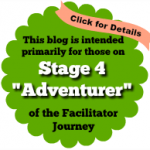Treat Your Groups to 6 Energizers From Our Menu


Here are a few really cool meeting energizers from colleagues whom I deeply respect or whose processes I have used and found to work extremely well. Please read also our earlier blog on why I normally disapprove of energizers just to energize or have fun! These energizers are relevant, fun and produce an outcome. The timing is estimated for groups of about 10-15 people. Add more time for larger groups.
I’ve also decided to use food images for the fun of it. See if you can see any connection between the photo we use and the activity we share with you. Use your imagination!
Simple ‘Get Acquainted’ Icebreaker
About 10-15 minutes

Self-divide into four “seasonal” groups: those born in the spring, summer, fall, winter months. Further pair off with the person whose month/day of birth is closest to theirs (sometimes a pair can become a trio). Ask them to find out at least two other things they have in common in addition to date of birth–other than the obvious (e.g. gender identity, serving on the team, physical characteristics). You can ask them instead to look for shared goals or shared reasons for serving on the team, etc. to tailor it to the group’s purpose.) Ask them to each share what they have in common.
Adapted slightly from Mary Jo Major, a ToP colleague
Team Ground Rule Creation –
How We Want To Work Together
About 30 minutes

Invite the team to create a ‘physical metaphor’ of how they would like to work together.
Groups come up with dances, orchestras, counterbalanced shapes and self supporting structures of all shapes and levels, parking a car, a rocket lifting off, etc.
As long as you are sensitive to cultures where physical touching might be very sensitive (instead focus on a visual metaphor or auditory metaphor versus acting it out), this activity works well with most multi-cultural groups. It has been used successfully in several large international organizations.
You can debrief this in several ways and at different levels: simply ask the groups to describe what their metaphor implies and then put them into small groups to create ground rules from this discussion; Or, ask them to present their own ground rules on a flip chart based on what their metaphor represents. You can take some time to merge or underline common themes among the ground rules.
Adapted slightly from Pamela (no last name), International Association of Facilitators Forum
Creative Opener: Wanted Poster
About 25 minutes

This opener allows each person to speak to the group. The poster creations can be posted on the wall through the session. You can come back to it later and have participants write appreciative statements to different individuals and post them on the right posters.
Ask each person to take a full sheet of white paper and divide it into three parts. Ask them to put their name on the poster and feel free to draw simple images to accompany any part of the poster. Have crayons and markers handy. Stickers of various animals can be helpful also. Here are three example parts they could fill out on their poster:
- Learning preferences: Choose an animal that describes your learning process. E.g., Spider – Work away until presto a great pattern emerges; Horse – I run here and run there looking for information; Owl – I sit and watch everything that goes on.
- Uniqueness: Share something unique about yourself that others do not know
- Job positives: What do you most like about your job?
Conduct a reflective conversation (this one follows the ToP ORID format) after all the posters are shared:
(O) Which images rose to the top for you?
(R) Where were you surprised to find a common connection with someone? Tell a story about that.
(I) What does this say about this team or group of people?
(D) What positive things are you concluding about this group?
Adapted from Larry (did not share his last name), a ToP colleague
Team Bragging – Get To Know You
About 10-15 minutes

Bring a bag of toys and objects from hardware or grocery stores. Arrange the objects on a table and put out a sign that says, “Pick an object that attracts you.” Invite the participants to introduce themselves using one of the objects as follows:
- Your Name
- Why you were asked to be part of this group? (It’s ok to brag)
- Why you accepted? (Let’s them speak about their commitment)
- How does the object you picked represent a talent or strength you bring to the group and its work?
Adapted from Elizabeth Crook & Associates, ToP colleagues
Team Expectations Opener
About 15-20 minutes

Pass around a bowl of M&Ms (i.e., multi-colored chocolate covered candies) You could also use glass beads or paper circles of many colors. Encourage everyone to take a handful. For every color they chose, they answer questions, coded to the color. Adapt the questions to your needs. Here are three options:
OPTION A: Get to know you personally…
- red = what is your favorite past time?
- green = what’s the best vacation you have taken?
- blue = if you could have dinner with anyone in the world, who would it be?
- brown = who is your hero and why?
OPTION B: Share team expectations…
Put the following questions on a flipchart, but only show them after everyone has had a turn at taking some of the colored objects
On three flip charts:
- red = What I expect of my team leader…
- green = What I expect of my team members…
- blue = What I expect of my self…
OPTION C: Share session expectations…
On two flip charts:
- What I want to get during this session…
- What I want to give during this session…
For each option, list participant responses as they share (if a group is less than 10) or have them write answers on individual large sticky notes (if group >10) and post on the correct flipchart. Have each person read out their answers if you use the sticky note method of sharing.
Adapted From Maggie Murphy-Maertz, ToP colleagues
Closing Circle of Appreciation
About 5-10 minutes

The group stands in a circle. Give a ball of string or wool to someone in the circle. S/he/they hold on to its end and throw the rest of the ball across the circle to another participant. They then say something they have appreciated about the person to whom they have thrown the ball of string. The receiver then holds onto the string and throws the ball across the circle to another participant. The process continues until everyone is holding onto the string and the ball has returned to the first person to throw it. You now have a wonderful network of string connections across the circle. Then you, the facilitator cuts the string connections between the participants – who then make a circle of their piece of string and tie to their wrist as a temporary bracelet – to remind them of the workshop and the appreciation they received.
Adapted slightly from Marilyn Oyler, a ToP colleague
Resources
Blog: Just Say “No” to Icebreakers
Blog: Ten Tried-and-True Team Building and Trust Building Techniques



Nice Idea!
Thanks for sharing.I remember when I was a facilitator last year and I was scared because my audience were teachers in the district. Its good because I am prepared. But I have limited of energizers .More power Barbara and God bless your work!
Thank you so much Maxima. Yes, we are all scared -sometimes more than others. glad you found this useful.